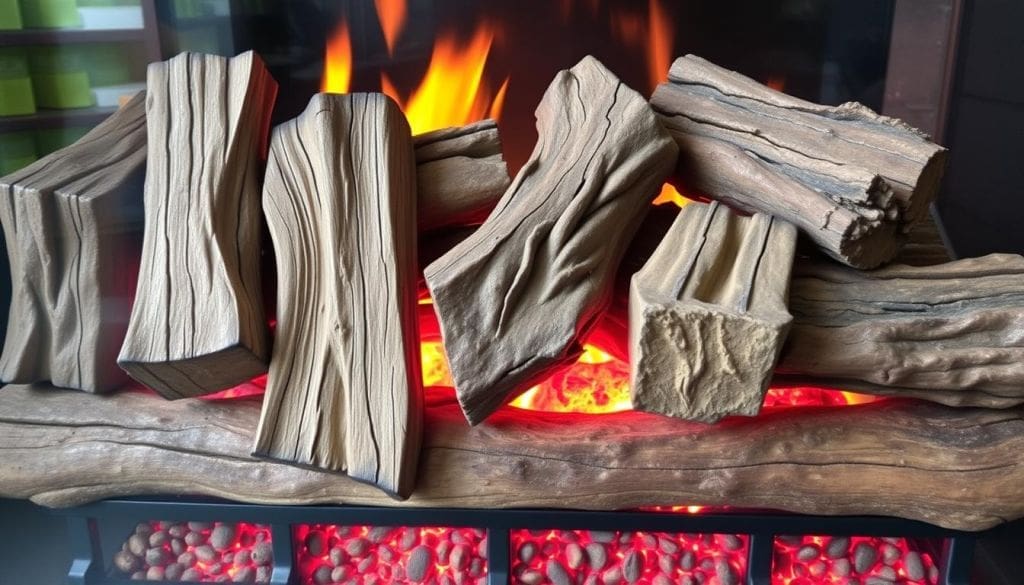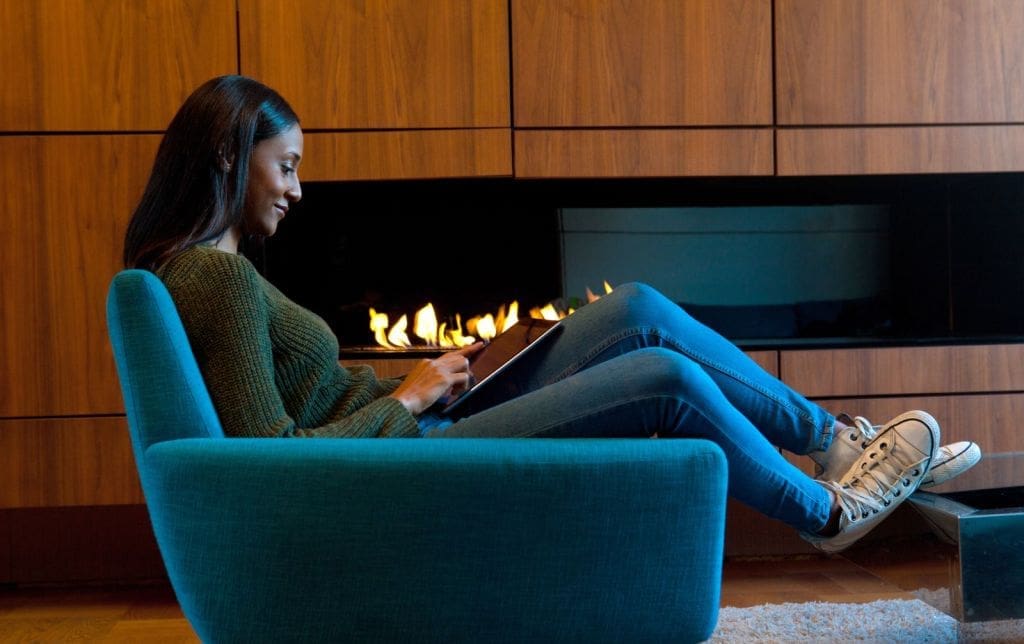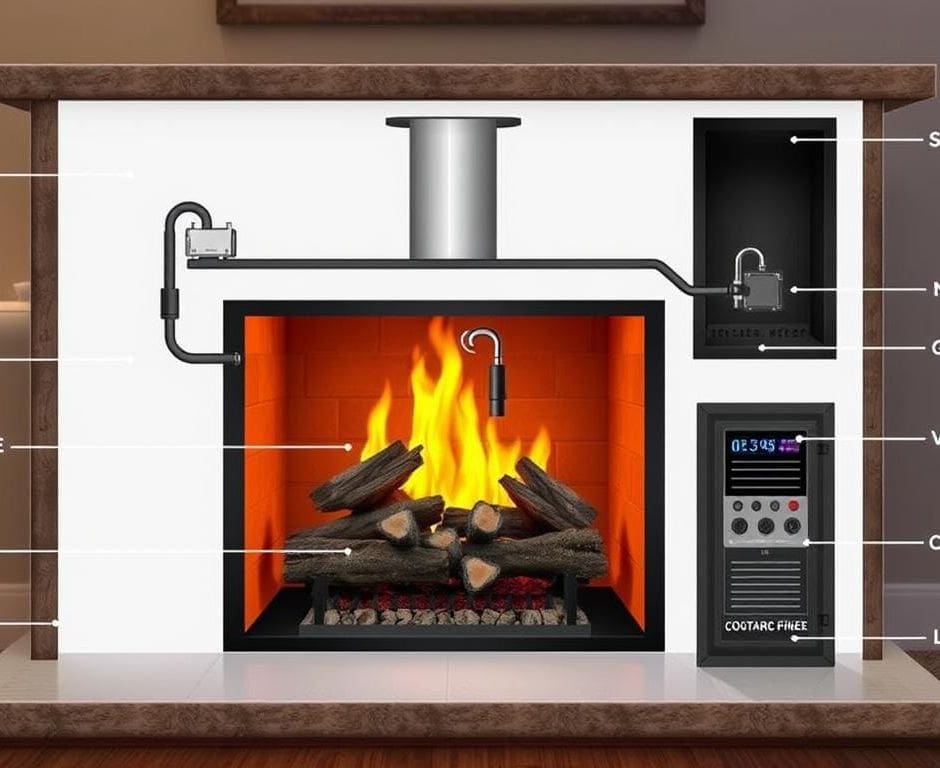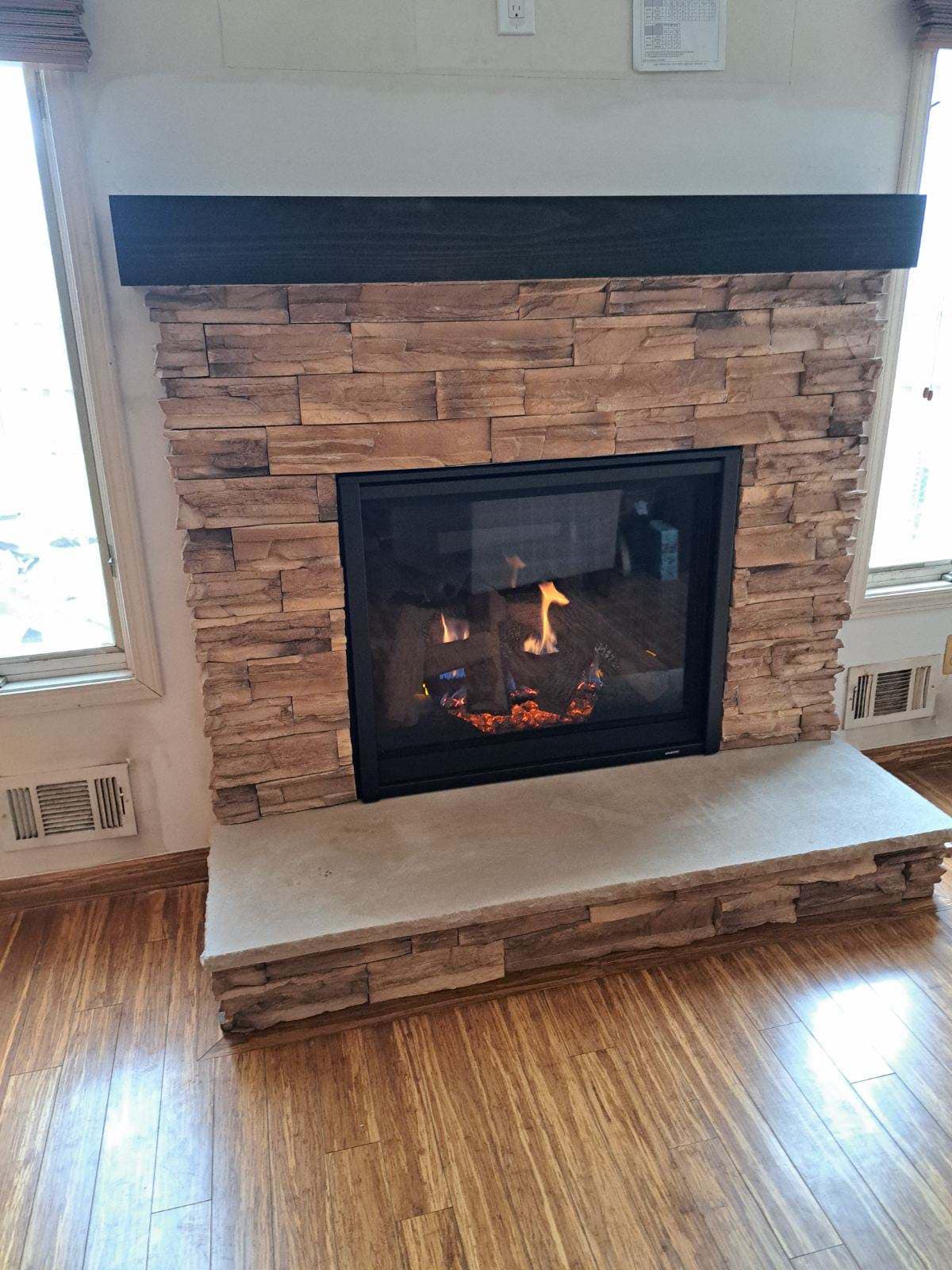Did you know natural gas fireplaces are growing fast? They now make up over 70% of fireplaces sold in the U.S. Homeowners love them for being efficient and easy to use. This guide will show you what makes up a gas fireplace and the different types you can choose from.
Key Takeaways
- Natural gas fireplaces are the fastest-growing segment of the fireplace market, with over 70% of all fireplaces sold in the United States being gas-powered.
- This guide covers the essential components of gas fireplaces and provides an in-depth look at natural gas fireplace options, installation, and maintenance.
- Discover the benefits of gas fireplaces and explore the different types available to find the perfect fit for your home.
- Learn about gas fireplace inserts, ventless gas fireplaces, direct vent gas fireplaces, gas fireplace logs, and more.
- Understand the importance of gas fireplace maintenance, safety, and accessory considerations.
Introduction to Gas Fireplaces
Gas fireplaces are a hit with homeowners looking for warmth and style. They’re efficient and easy to use, making them a great choice over traditional wood-burning fireplaces.
Benefits of Gas Fireplaces
Gas fireplace inserts are easy to control. Just turn a knob or press a remote, and you’re set for a cozy fire. They’re also energy-efficient, saving you money on heating costs.
Gas fireplaces are also low maintenance. Unlike wood-burning fireplaces, ventless gas fireplaces and direct vent gas fireplaces don’t need constant cleaning. This means you can enjoy a fire without much work.
Types of Gas Fireplaces
Homeowners have many options for gas fireplaces. Gas fireplace inserts fit into existing fireplaces, making them a smart upgrade. Ventless gas fireplaces don’t need a chimney, perfect for homes without one. And direct vent gas fireplaces use outside air for safe and efficient burning.
No matter the type, gas fireplaces bring warmth and style to any room.
Components of Gas Fireplace – Guide to Natural Gas Fireplaces
To design the perfect natural gas fireplace, you must know its key parts. Each part, from the burner to the venting system, is vital for a safe and efficient fireplace. Let’s explore the essential components of a natural gas fireplace and how they work together.
The Burner
The burner is the heart of the natural gas fireplace. It ignites the fuel and creates the flames. Burners come in different styles, from traditional log-style to modern linear designs. The size and design of the burner affect the fireplace’s heat and flame look, letting homeowners pick the best for their space.
Controls and Safety Features
Natural gas fireplaces have advanced controls and safety features. These include thermostats, remote controls, and automatic shut-off. They monitor temperature, gas flow, and fireplace performance. These features give homeowners control and peace of mind.
Venting System
The venting system is key for a natural gas fireplace. It carries combustion byproducts out of the home. There are direct vent and natural vent systems, each with its own needs and performance. Knowing about venting options is crucial for safe and proper fireplace operation.
Understanding the components of a natural gas fireplace helps you choose the right one for your home. With the right knowledge, you can enjoy the warmth, ambiance, and convenience of a natural gas fireplace that fits perfectly in your living space.
| Component | Description |
|---|---|
| Burner | The central component responsible for igniting the fuel and creating the flames. |
| Controls and Safety Features | Mechanisms that regulate temperature, gas flow, and overall fireplace operation for safe and efficient use. |
| Venting System | The system that channels the combustion by products out of the home, either through direct or natural venting. |
Gas Fireplace Inserts
If you have an existing wood-burning fireplace, consider upgrading to a gas option. Gas fireplace inserts fit right into your current fireplace. They turn it into a modern, energy-efficient gas unit.
Advantages of Gas Fireplace Inserts
Gas fireplace inserts come with many benefits:
- They are more energy efficient than wood-burning fireplaces. This means better heat and lower costs.
- They are easy to use. Just press a button or turn a dial to control the flame and heat.
- They are cleaner and safer. No smoke, soot, or flying embers like with wood-burning fireplaces.
- They can increase your home’s value. A smart investment for your home.
Installation Process
Installing a gas fireplace insert is easy. Here’s what you need to do:
- Measure your fireplace opening to make sure the insert fits.
- Choose the right gas insert model for your needs and fireplace size.
- Get a licensed technician to install it. They’ll connect it to the gas supply and ensure proper venting.
- Do any electrical work needed, like installing a power source for the insert’s blower or control system.
- Make sure the installation meets safety standards and gets the necessary permits.
Upgrading to a gas fireplace insert brings warmth and ambiance with natural gas’s convenience and efficiency. It’s a great way to improve your home’s energy use or enhance your living space.
Ventless Gas Fireplaces
Ventless gas fireplaces are a cozy and efficient way to warm up your home. They don’t need a chimney or venting system. This makes them perfect for those who want a fireplace without the hassle of installation.
These fireplaces are easy to install. They don’t need a chimney or venting, so the setup is simple and affordable. This is great for homes where a traditional fireplace isn’t possible.
Ventless gas fireplaces are also very efficient. They turn almost all the natural gas they use into heat. This makes them a cost-effective heating option. Plus, they come in many styles, fitting well into any home decor.
But, there are rules and safety concerns to keep in mind. Homeowners should check local laws before installing one. It’s also key to maintain them and install carbon monoxide detectors for safety.
In summary, ventless gas fireplaces are a smart choice for adding warmth to your home. They’re easy to install and come in many designs. They can greatly improve your home’s ambiance and comfort.
Direct Vent Gas Fireplaces
Direct vent gas fireplaces are a smart choice for heating your home. They use a sealed system that pulls air from outside. This makes them more efficient and better for the environment than traditional fireplaces.
How Direct Vent Fireplaces Work
These fireplaces have a sealed chamber that connects to the outdoors. They draw in fresh air for burning and send exhaust gases outside. This keeps the air inside clean and safe.
Pros and Cons of Direct Vent Fireplaces
Direct vent fireplaces are energy-efficient and safe. They also reduce indoor pollution. But, they might cost more upfront and need a more complex installation. Think carefully about these points before deciding.
| Pros of Direct Vent Fireplaces | Cons of Direct Vent Fireplaces |
|---|---|
| Improved energy efficiency Enhanced safety with sealed combustionReduced indoor air pollutionVersatile installation options | Higher upfront cost More complex installation process Dependency on outdoor air supply Potential for venting issues |
Before choosing a direct vent gas fireplace, consider your needs and budget. Knowing how they work and their pros and cons helps you make a good choice. This ensures your home heating needs are met.
Gas Fireplace Logs
Choosing the right gas fireplace logs can really enhance your fireplace. There are many options, from classic ceramic logs to modern refractory ones. Each type can match your style and needs perfectly.
Types of Gas Fireplace Logs
Let’s look at the different types of gas fireplace logs:
- Ceramic Logs – These logs look like real wood and are made from ceramic. They add warmth and a cozy feel to your fireplace.
- Refractory Logs – These logs are made to withstand high heat and have a sleek, modern look. They also heat your space efficiently.
- Vented Logs – These logs work with traditional wood-burning fireplaces. They give a natural flame look and can save you money by upgrading your fireplace.
Whether you like classic or modern looks, the right gas fireplace logs can make your fireplace more appealing and functional. It becomes a cozy spot in your home.

Gas Fireplace Remote Controls
Gas fireplace remote controls make it easy to adjust your fireplace settings from your chair. They let you change the flame height, temperature, and more. This makes your gas fireplace experience better.
Unlock the Benefits of Gas Fireplace Remote Controls
Gas fireplace remote controls are very useful. They let you control the flame and temperature with just a few clicks. You can also turn your fireplace on and off without getting up.
Customizing Your Gas Fireplace Experience
There are many types of gas fireplace remote controls. Some let you adjust the flame height, while others control the temperature. You can even set timers or custom settings. This lets you make your fireplace just how you like it.
| Remote Control Feature | Benefit |
|---|---|
| Flame Height Adjustment | Allows you to create the perfect ambiance by adjusting the flame size |
| Temperature Control | Enables you to maintain the desired temperature in your living space |
| Timers and Programmable Settings | Lets you automate your gas fireplace’s operation for convenience and energy efficiency |
Gas fireplace remote controls are great for making your home cozier or more relaxing. They are easy to use and offer many features. Look for the one that fits your needs best.
Gas Fireplace Maintenance
Keeping your gas fireplace in good shape is key for safe and efficient use. Regular cleaning and checks can make your appliance last longer and work better. Let’s look at how to keep your gas fireplace in great condition.
Cleaning and Inspecting Your Gas Fireplace
First, turn off the gas and let the fireplace cool down. Then, you can start cleaning and doing maintenance. Here’s what to do:
- Take out the glass panel and clean it with a special glass cleaner for high-heat surfaces.
- Use a brush or vacuum to clean the logs, burners, and inside parts of the fireplace.
- Check the pilot light to make sure it’s lit and working right.
- Look at the gas lines and connections for any wear or damage.
- Make sure the venting system is clear and not blocked.
Professional Maintenance Services
While you can do some maintenance yourself, getting a professional to check your gas fireplace once a year is a good idea. A skilled technician can do a detailed check, clean parts, and find any problems. This professional help ensures:
- Your gas fireplace is safe to use
- It works better and more efficiently
- It lasts longer
- You follow the maker’s rules and keep the warranty valid
By following these fireplace maintenance tips, you can keep your gas fireplace in excellent condition. This way, you can enjoy its warmth and beauty for many years.
Gas Fireplace Installation
Getting ready for a gas fireplace in your home needs careful thought. You must consider the size of your space and the gas line type. These factors are key for a smooth installation.
Factors to Consider Before Installation
Before starting your gas fireplace project, think about these important points:
- Space Requirements: Measure the area for your gas fireplace. Make sure it fits well and matches your room’s design.
- Gas Line Compatibility: Find out what gas line your fireplace needs. It could be natural gas or propane. Make sure your home’s gas system can handle it.
- Permits and Regulations: Look into local building codes for gas fireplaces. Get the needed permits before you start.
- Ventilation Requirements: Think about your fireplace’s ventilation needs. Some might need a direct vent or a ventless system, affecting the install.
- Electrical Considerations: Check if your fireplace needs electricity. This includes power for the fireplace or remote control.
By focusing on these points, you can have a successful gas fireplace installation. It will meet safety and legal standards, and make your home cozier.
“Proper planning and consideration of key factors are essential for a successful gas fireplace installation that meets all safety standards and enhances the ambiance of your home.”

Gas Fireplace Safety
Keeping your gas fireplace safe is very important. By taking a few key steps, you can keep your family safe. This way, you can enjoy the warmth and look of your fireplace without worry.
Carbon Monoxide Detectors
Carbon monoxide is a silent killer that you can’t smell or see. It’s crucial to have reliable carbon monoxide detectors near your gas fireplace. These devices will warn you if the gas is at dangerous levels, so you can act fast.
Fireplace Safety Tips
- Ensure proper ventilation: Gas fireplaces need good venting to work safely. A pro should check the venting system regularly.
- Schedule annual maintenance: Get your gas fireplace checked and serviced by a pro every year. This helps catch and fix problems before they’re big safety issues.
- Keep the area clear: Make sure there’s a safe space between your gas fireplace and things that can burn, like furniture or curtains. This lowers the chance of fires.
- Supervise children and pets: Never leave kids or pets alone near a lit gas fireplace. Teach them about fireplace safety and set clear rules.
- Use caution when operating: Always follow the maker’s instructions when lighting, adjusting, or turning off your gas fireplace. Stay away from actions that could make it unsafe.
By sticking to these gas fireplace safety tips, you can enjoy your gas fireplace while keeping your family safe. Always remember, safety comes first when using any gas-powered appliance.
Gas Fireplace Accessories
Make your gas fireplace the heart of your living area with stylish accessories. Choose from decorative screens to customizable glass doors. These items boost both looks and use of your fireplace.
Fireplace Screens
Fireplace screens are both useful and stylish. They keep your family safe from sparks and add elegance. With many materials, finishes, and designs, they fit right into your home’s style.
Glass Doors
Custom glass doors can make your gas fireplace look better. They also make it more efficient by keeping heat in and drafts out. You can pick from modern to classic styles to match your taste.
Decorative Elements
- Fireplace andirons: These metal supports add a classic touch to the front of your gas fireplace, elevating the overall aesthetic.
- Fireplace grates: These functional accessories hold the gas fireplace logs in place, while also contributing to the visual appeal of your setup.
- Fireplace tools: A set of decorative fireplace tools, such as a poker, tongs, and shovel, can enhance the ambiance of your gas fireplace area.
Check out the many gas fireplace accessories to make your fireplace a stunning centerpiece. These items can improve both function and beauty, turning your gas fireplace into the room’s highlight.
Conclusion
This guide has covered the key parts of gas fireplaces. It also gave insights into natural gas fireplace options, installation, and upkeep. Whether you’re looking to get a new gas fireplace or upgrade an old one, this info will guide you. It helps you make smart choices and enjoy the warmth and ambiance of a gas fireplace at home.
If you need help with your gas fireplace, our team at [Company Name] is ready to assist. Call us at (732) 641-0740 for a free estimate on all fireplace services. We aim to make sure your gas fireplace works safely and efficiently. This way, you can relax and enjoy the cozy atmosphere it brings to your living space.
With this guide, you can confidently explore the world of gas fireplaces. You’ll make the best choice for your home and enjoy its benefits for many years. Let the flickering flames of a gas fireplace warm your heart and your home.
FAQ
What are the essential components of a gas fireplace?
A gas fireplace has several key parts. These include the burner, controls, and a venting system. Safety features like pilot lights and thermocouples are also important. Knowing how these parts work together is key for proper use and upkeep.
What are the different types of gas fireplaces available?
There are a few main types of gas fireplaces. These include inserts, ventless, and direct vent models. Each type has its own benefits and requirements. It’s important to think about your home’s layout and energy needs when choosing.
What are the advantages of a gas fireplace insert?
Gas fireplace inserts are great for upgrading an old fireplace. They’re efficient, easy to control, and burn cleaner than wood. They fit right into your existing fireplace, making them a popular choice.
How do ventless gas fireplaces work?
Ventless gas fireplaces don’t need a chimney. They pull air from the room and vent the exhaust back in. They’re cost-effective but safety and local rules must be considered before installing.
What are the key features of direct vent gas fireplaces?
Direct vent fireplaces draw air from outside and vent exhaust outside. They’re efficient and safe. They also provide better air quality than other types.
What types of gas fireplace logs are available?
You can find different styles of gas fireplace logs. Options include ceramic, refractory, and vented logs. Each style offers a unique look and performance, letting you customize your fireplace.
How can I control my gas fireplace remotely?
Many gas fireplaces come with remote controls. These let you adjust the flame and temperature from your seat. It makes using your fireplace more convenient and enjoyable.
How do I maintain my gas fireplace?
Keeping your gas fireplace in good shape is important. Clean the burner, glass, and venting system regularly. Also, have a professional inspect it yearly. This helps it last longer and work better.
What factors should I consider before installing a gas fireplace?
Before installing a gas fireplace, think about your home’s size and layout. Check if you have the right gas line and if local codes apply. These steps ensure a smooth installation.
How can I ensure the safety of my gas fireplace?
Safety is key with gas fireplaces. Install carbon monoxide detectors and follow venting rules. Have it checked yearly by a pro. Knowing how to use and maintain it safely is also important.
What accessories are available for gas fireplaces?
There are many accessories for gas fireplaces. You can find screens, glass doors, and decorations. These can enhance your fireplace’s look and function, making your space more inviting.






